Study of Vortex Induced Characteristics of Multi-columns with Low Mass Ratio
2014-01-19GUJiayangYANGJianminXIAOLongfei
GU Jia-yang,YANG Jian-min,XIAO Long-fei
(1.School of Naval Architecture and Marine Engineering,Jiangsu University of Science and Technology,Zhenjiang 212003,China;2.State Key Laboratory of Ocean Engineering,Shanghai Jiao Tong University,Shanghai 200240,China)
Study of Vortex Induced Characteristics of Multi-columns with Low Mass Ratio
GU Jia-yang1,YANG Jian-min2,XIAO Long-fei2
(1.School of Naval Architecture and Marine Engineering,Jiangsu University of Science and Technology,Zhenjiang 212003,China;2.State Key Laboratory of Ocean Engineering,Shanghai Jiao Tong University,Shanghai 200240,China)
Vortex-induced motion(VIM)of an offshore platform with multi-columns is an area of significant focus in the field ocean engineering.VIM involves the complex fluid-structure interaction problem.In this paper,the Reynolds-averaged Navier-Stokes solver combined with the shear-stress transport k-ω turbulence model for the Navier-Stokes equations was used to simulate the VIM of multi-columns with low mass ratio for different flow-approaching angles and reduced velocities.The values of natural period and dimensionless damping coefficient for columns were taken from the model test in the State Key Laboratory of Ocean Engineering of Shanghai Jiaotong University.A computational grid was set up using GAMBIT software.The coupling fluid-structure interaction between the columns and the flow field was obtained by calculating the instantaneous lift and drag forces acting on the multi-columns caused by the external flow field.The differential motion equation was solved by fourth-order Runge-Kutta method,which was manually written into the user-defined functions,and dynamic mesh technology was then adopted to update flow field.The maximum and nominal statistics methods were used to analyze the amplitude of VIM.When the reduced velocities were small,the ‘jump’ phenomenon was observed in the amplitude curve for 0°flow-approaching angle regardless of whether motion in the stream-wise direction was limited.The maximum amplitude was 0.5D when motion in the stream-wise direction was not limited and was slightly smaller than the maximum amplitude of the limited motion in the stream-wise direction 0.57 D).The restriction of motion in the stream-wise direction and the selection of statistical method significantly affected the size of the ‘lock-in’region.Galloping at the low-frequency and multiple-frequency lock in phenomena was observed for the flow-approaching angles of 0°and 45°.Variation trends of equilibrium position with reduced velocity were very close for the three typical flow-approaching angles.When the reduced velocity was greater than 6.0,the maximum stream-wise amplitude heading was 22.5°,whereas the minimum stream-wise amplitude heading was 0°heading.The vortex shedding pattern of multi-columns showed the 2P mode.
multi-columns;VIM;dynamic mesh;lock in;low mass ratio
1 Introduction
The study of numerical simulation and model test for vortex-induced motion(VIM)started with research on the VIM of a spring-constrained rigid circular cylinder,which is the most representative work by Willamson et al[1-4].Based on this study,the VIM of multi-columns has recently become an area of research focus.The effect on VIM of different configurations,such as serial,parallel,and multi-columns,is emphasized.The spacing ratio of columns is also considered[5-6].
The primary underwater structures of tension-leg platform(TLP)and semi-submersible platform are similar.Both platforms commonly have four columns of the cross-section type,which primarily includes square and circular shapes.Research on the VIM of offshore platforms with multi-columns can be conducted using two primary methods.The first method is numerical simulation.Commercial software,such as Fluent and CFX,are used to conduct numerical simulation with a focus on the VIM of a single column or four columns.The other method is experimental study.
Yalpaniyan et al employed the volume-of-fluid method to simulate flow around the TLP with a laminar and turbulent solver[7].The existence of upstream column vortices affects the flow field of downstream columns,which then causes the vortex intensity of upstream columns to be greater than that of the downstream columns.Magee et al discussed model tests for the VIM of a TLP near the southern tip of the Malaysian Peninsula[8].First,decay tests were conducted on the TLP to obtain the values of the natural period and dimensionless decay coefficient.Second,VIM tests primarily studied the effect of flow velocity,current heading,and dimensionless draft(ratio of draft to characteristic length of column)on the VIM of a TLP.Kim et al investigated the VIM of a TLP by employing AcuSolve and STAR-CCM+software,respectively[9].The principal platform dimensions were 57.3 m×57.4 m,and the column diameter was 12.8 m.However,the study only considerered one current heading and three different reduced velocities.Thus,reflecting the vortex-induced characteristics of TLP is difficult.Waals et al conducted a model test for the VIM of four different platforms[10].The platforms were as follows:deep-draft semi-submersible(four pontoons;mass ratio,0.84),deep-draft semi-submersible(two pontoons;mass ratio,0.83),deep-draft TLP(four pontoons;mass ratio,0.57),and deep-draft TLP(four pontoons;mass ratio,0.83).The study found that lower mass ratios,such as those for conventional TLPs,may result in larger sway response.Two pontoons can generate larger motion response at higher Ur(Ur>10).The yaw motion amplitude for the 0°tow direction linearly increased with reduced velocity,and the yaw motion for the 45°tow direction was small(<1°).
Zhao et al used a finite element method to solve the two-dimensional Reynolds-averaged Navier-Stokes equations and shear-stress transport(SST)k-w turbulence equations[11].Simua-ations were conducted for flow-approaching angles of α=0°,15°,30°and 45°,and the reduced velocities ranged from 1 to 20 with an interval of 1.The results of this research can be referred to the study of the VIM of TLPs in two dimensions.Xu et al have investigated the vortex-induced vibrations of four cylinders in an in-line square arrangement with low Reynolds number using a finite element method[12].The cylinder motion was modeled using a mass-springdamper system.The nonlinear coupling interactions between the cylinder and the flow field were studied through a dynamic mesh model.The mean and fluctuating aerodynamic forces,response characteristics,and vortex shedding pattern in the wake for each cylinder were primarily analyzed with a spacing ratio L/D from 2.5 to 6.0.Multi-columns of TLP move as a whole,which is the primary difference from the VIM work of Xu,considering that their research method has a certain guidance function.
Rijen et al performed a model test to analyze the effect of current and wave on the VIM of a semi-submersible platform[13].The results showed that the presence of waves delayed the onset of VIM,but did not affect the VIM response.Rijen et al also investigated the effects of hull appendages,mooring system,and external damping on VIM.Ng et al studied the characteristics of flow in the wake region of a vertical bluff cylinder in waves,currents,and combined wave-current flows using a model test[14].Hong et al analyzed the effect of waves on the VIM of a deep semi-submersible platform[15].The research indicated that the sway motion amplitude is evident as VIM occurred.The sway motion amplitude was not only related to currents nor waves.Under a strong current condition,a smaller wave generates greater motion amplitude.
The VIM of a TLP is more complicated because of the low mass ratio of such platform when compared with a the vortex-induced vibration of a single rise,regardless of mesh optimization,movement zone setup,selection of turbulence model,determination of the relaxation factor,and so on.Recent research on VIM focused on the spar platform.The investigation of VIM on semi-submersible platform and TLP,as types of multi-columns platforms,was the primary focus.Based on the combined self-development program of commercial software,this paper focuses on the vortex-induced characteristics of a TLP.
2 Numerical computation model
2.1 Governing equations
2.1.1 Governing equations of computational fluid dynamics


The SST k-ω model serves as a turbulent flow model.The transport equation of the turbulence kinetic energy k and its rate of dissipation ω are given by

2.1.2 Dynamical governing equation in dimensionless forms

2.2 Computational model
A multi-column structure is simplified into a spring-mass-damping system.Considering whether motion in the stream-wise direction is limited,two kinds of computational model are established for the 0°flow-approaching angle.For a flow-approaching angle of 22.5°or 45°,only the condition of unlimited motion in the stream-wise direction is considered.The rectangle computational region is 20 D×60 D(D=0.435 m)with 15 D upstream,45 D downstream,and 8 D move zone set up.In this model,mixed grids are used,the region near the column is meshed by an intensively structured mesh,and the remainder of the region adopts an unstruc tured mesh.Fig.1 shows the computational grid for different flow-approaching angles as well as the zoomed-in view of the grid near the column corner.
The SST k-ω turbulence model and the unsteady,first-order implicit solver are employed for the numerical calculation.The coupled algorithm is used to solve the velocity and pressure coupling equations,whereas the second-order upwind is selected to determine the momentum,turbulence kinetic energy,and rate of dissipation.The flow direction is from left to right,with the left side as the velocity inlet and the right side as the pressure outlet.The relative pressure is set as 0,upper and lower free-slip boundaries are set as symmetrical,and the model surface is set as a wall.
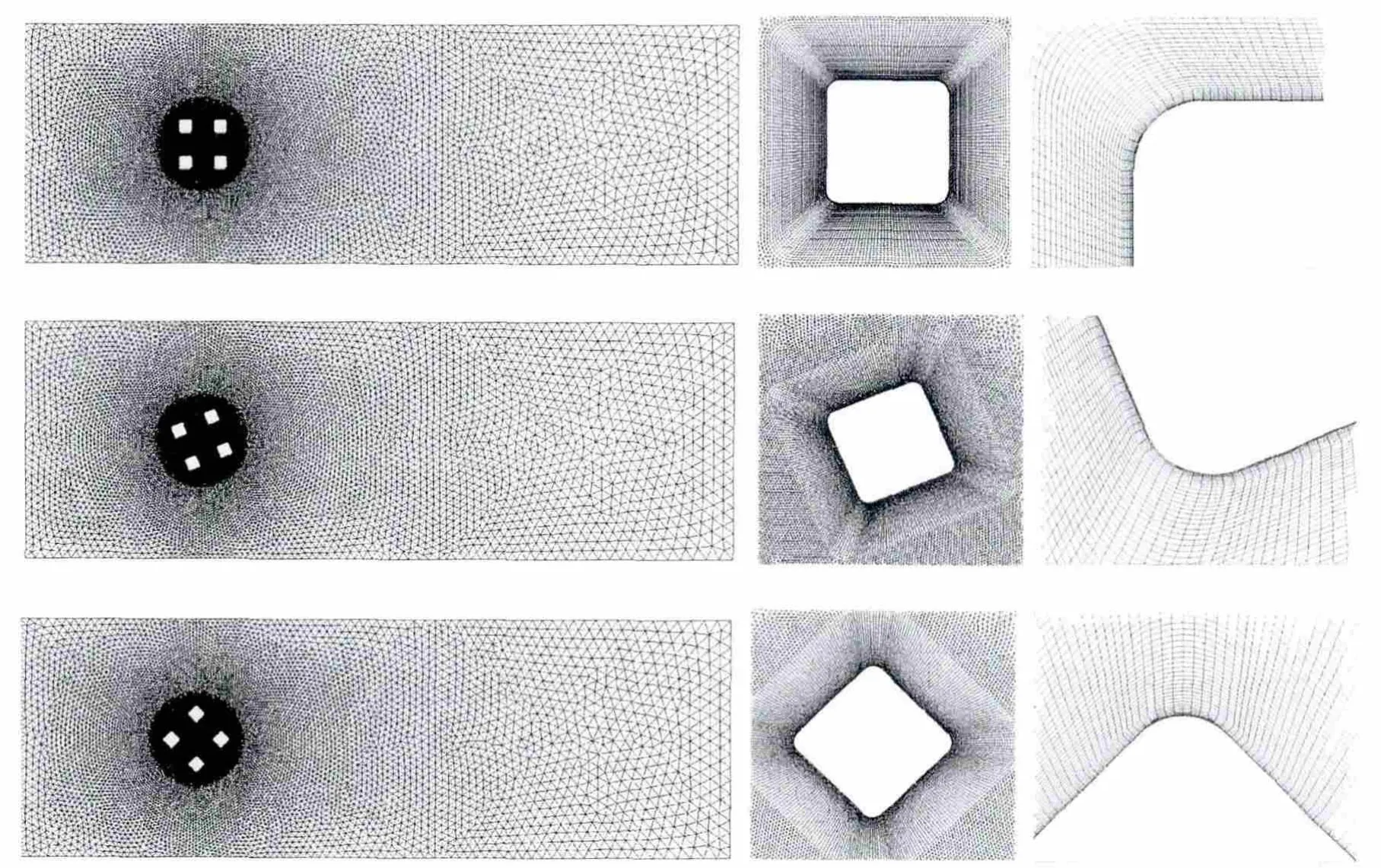
Fig.1 Computational grid of four columns
Multi-columns move in the water as a rigid body,and the interaction between multicolumns and the flow field must be considered.The governing equation of fluid,velocity field,and pressure field is solved by Fluent software,through which the lift-and-drag force acting on columns can be acquired.User-defined function is adopted to acquire the force acting on columns,which will then be taken into the dynamical governing equation.Using the fourthorder Runge-Kutta program,the acceleration,velocity,and displacement of columns can be obtained.The column is then provided a new position through the DEFINE_CG_MOTION function,and the flow field parameters are updated.The new flow field consequently affects the movement of multi-columns,thus causing the cycle to continue.Dynamic mesh technology is adopted to realize the movement of columns and to update the flow field.The time step of this simulation is 0.05 s.The new position and force of columns in the current time step are based on the velocity and force from the previous time step.
3 Natural period and dimensionless decay coefficient
To determine the oscillation period of multi-columns,a decay model test must be performed.The model test was conducted in the State Key Laboratory of Ocean Engineering of Shanghai Jiaotong University.According to the decay test results in still water,natural periods of surge,sway,heave,roll,pitch,and yaw are 102.4,104.5,2.76,2.37,2.32 and 75.4 s,respectively.Dimensionless damping coefficient of surge,sway,heave,roll,pitch,and yaw are 0.086,0.029,0.007,0.038,0.038,and 0.17,respectively.

Fig.2 Surge and sway decay curves obtained from model test
4 Calculation results and analyses
4.1 VIM response of multi-columns for 0°flow-approaching angle
This paper adopted two kinds of statistical methods for amplitude statistics.The results are analyzed in a comparative manner,and the statistical methods are as follows:

Figs.3 and 4 show the time history of VIM at reduced velocities of 3.0,6.0,8.0,11.0 and 14.0 for limited and unlimited motions in the stream-wise direction.The lift-and-drag forces induced by multi-column VIM determined the VIM variation trend in the stream-wise and transverse directions.The vortex-induced characteristics for unlimited motion in the streamwise direction are first analyzed.When the reduced velocity is 3.0,the time history curves of stream-wise and transverse displacement gradually stabilized and became regular after 300 s,which is close to the sine wave.The maximum displacement is approximately 0.17 D,and the minimum displacement is 0.12 D in the stream-wise direction,such that the amplitude is only 0.05 D.In the transverse direction,the amplitude is 0.45 D,which is greater than the amplitude in stream-wise direction.A phase difference exists between the transverse and streamwise time history curves.The stream-wise phase is larger than the transverse phase.With an increase in reduced velocity,the effect of the upstream column on the downstream column gradually strengthens,such that the regularity of the time-history curves for stream-wise and transverse displacement is gradually decreased.When stream-wise motion is limited,the variation trend of transverse amplitude using two different statistical methods remains consistent(Figs.5 and 6),but the size of amplitude differs,and a “jump” phenomenon occurs in the vari ation trend of multi-column amplitude at low reduced velocity.The maximum amplitude of 0.50 D appears at a reduced velocity of 3.5 for two kinds of statistical methods.If the reduced velocity exceeds 4.0,the value of maximum amplitude when adopting the maximum statistical method locks in at 0.47 D.When adopting the nominal response method,the maximum amplitude locks in at 0.31 D.Therefore,with the increase in reduced velocity,transverse amplitude becomes stable.The equilibrium position has a linear relationship with the increase of reduced velocity.At the reduced velocity of 15.0°for 0°heading,the distance that multi-columns deviate from the initial position is 2.87 D.
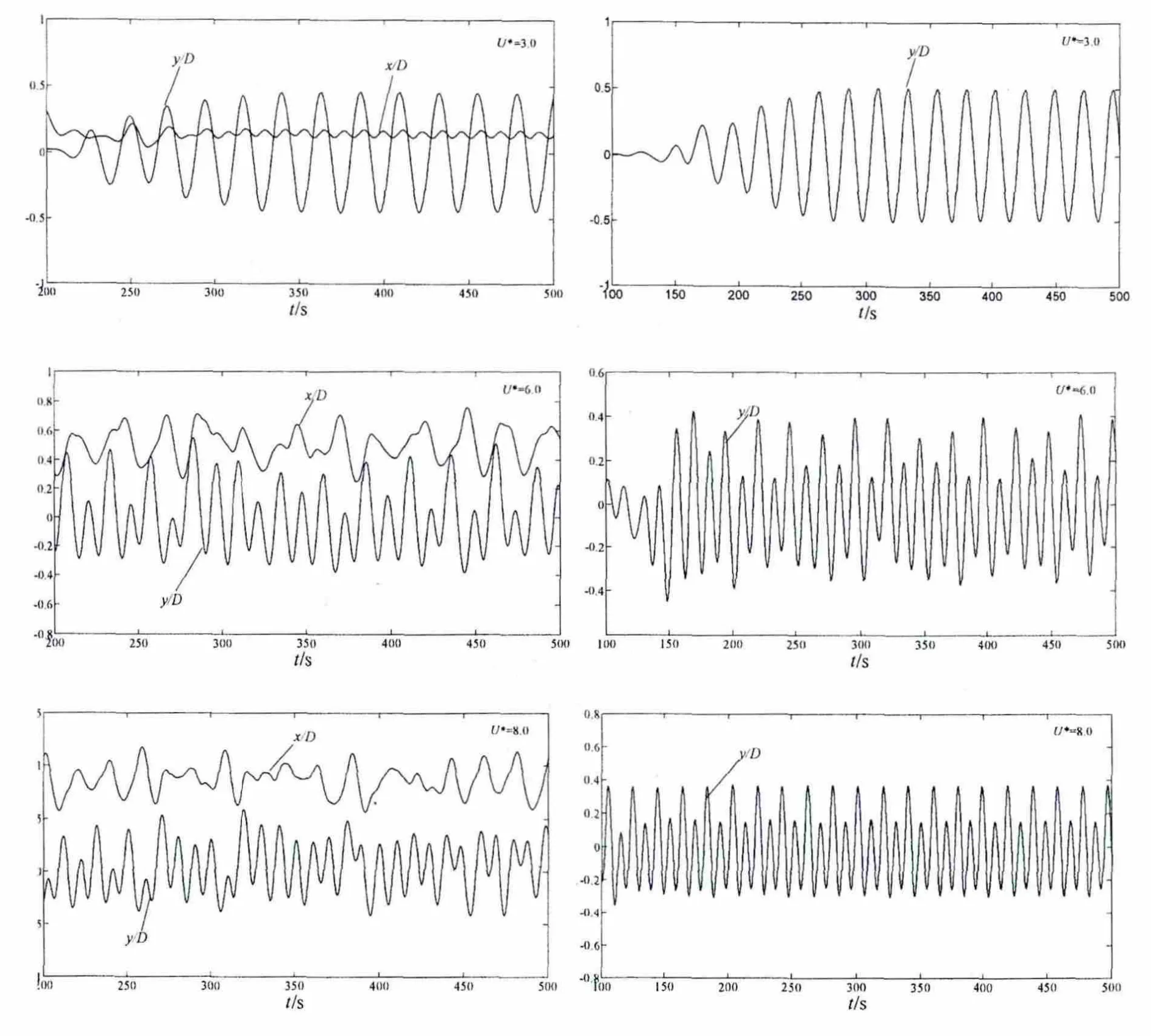

Fig.3 Time history of stream-wise and transverse amplitudes at different reduced velocities for unlimited motion in the stream-wise direction

Fig.4 Time history of stream-wise and transverse amplitudes at different reduced velocities for limited motion in the stream-wise direction
Vortex-induced characteristics for unlimited motion in the stream-wise direction have been analyzed.According to the numerical simulation of a circular cylinder VIM,the unlimited motion condition can generate greater transverse amplitude.Comparing Figs.3 and 4,the transverse displacement curve is more regular under limited motion in the stream-wise direction,the maximum amplitude for maximum statistical method is 0.57 D,and the result is 0.56 D for the nominal statistical method,indicating that the results are close.When the reduced velocity exceeds 5.0,the value of transverse amplitude for unlimited motion condition is greater than that of the limited motion in stream-wise direction regardless of the statistical method employed,indicating that the result is consistent with the classical theory of the VIM of a circular cylinder.The computational results also verify the correctness and reliability of the fluidstructure interaction program.Nevertheless,results using the maximum statistical method are significantly greater than those using the nominal response method.Regardless of the statistical method employed and regardless of whether the motion in the stream-wise direction is limited,a significant amplitude ‘jump’ phenomenon occurs when the reduced velocity is small,especially when the reduced velocities vary from 2.5 to 3.0 and 3.0 to 3.5.A similar phenomenon was observed when investigating the VIM of a single circular cylinder at a high mass ratio.Given the space constraints,this paper does not provide more time-history curves.However,an apparent“clap” phenomenon is observed in the time-history curve of transverse amplitude when the reduced velocity exceeds 10.0.

Fig.5 Variation trend of transverse amplitude with reduced velocity for 0°flow-approaching angle
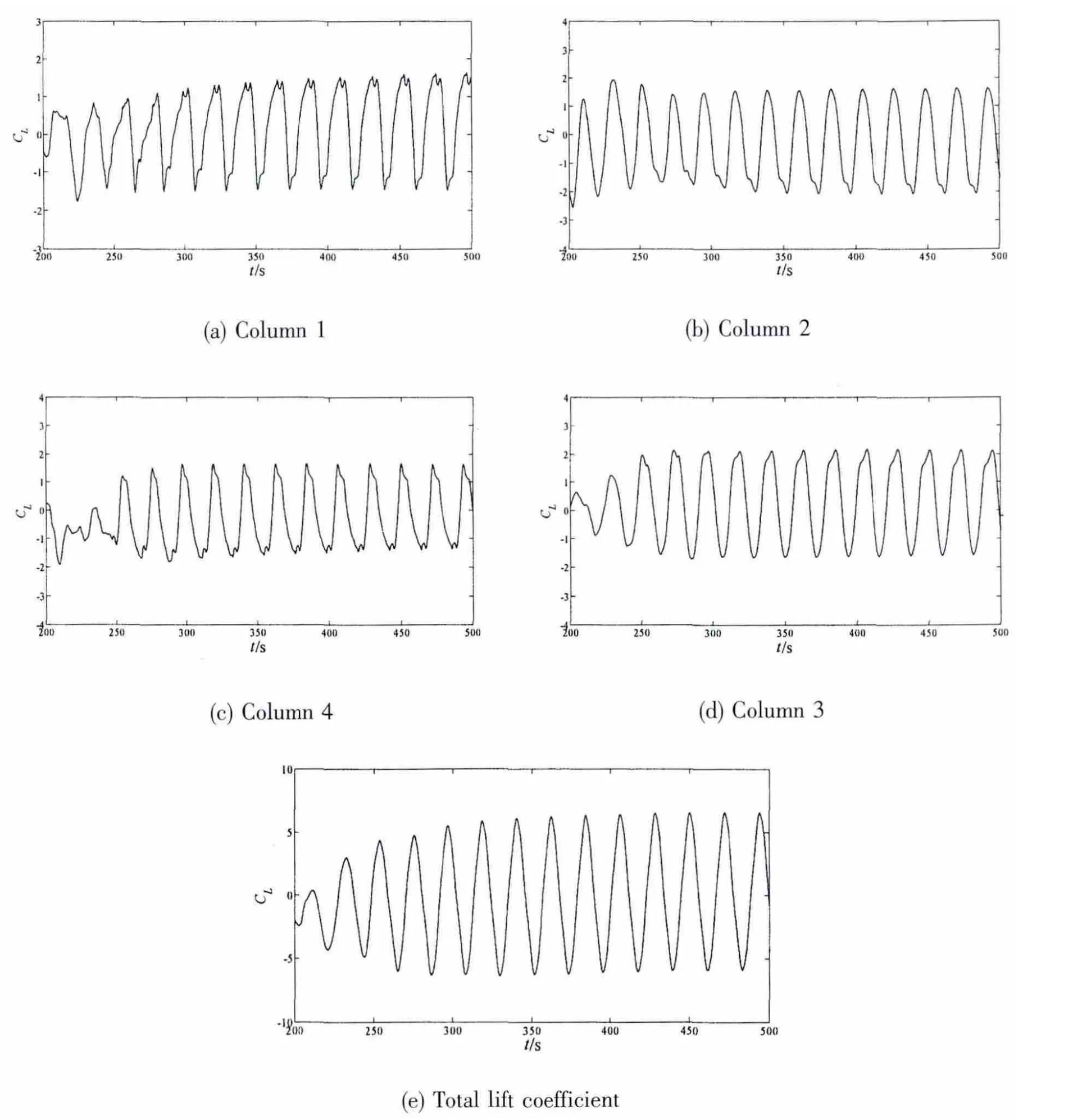
Fig.6 Time series of lift coefficient on each column and total for 0°heading,U*=3.5
In this study,multi-columns move as a whole.While modeling using Gambit software,the four columns can be set as a whole wall,and the mechanical characteristics of the platform can be analyzed.However,the method is incapable of analyzing the mechanical characteristics of each column.To analyze the interference problem among multiple columns,the four columns will be set as four walls,but the 8 D move zone associated with multi-columns is set as a whole zone with superimposed hydrodynamic force to facilitate calculation.Fig.6 shows the mechanical characteristics of each column and the total lift force.The lift coefficient curve is no longer a simple regular curve at steady stage because of the coupling effect among the four columns,which is identified with jagged shape at the top and bottom of the lift coefficient curve.The space ratio of columns is 2.9.A greater space ratio causes the coupling effect among the columns to be weaker.The jagged shape of the lift coefficient for upstream and downstream columns is complemented,such that the total lift coefficient curve becomes stable.Comparing the amplitude of the lift coefficient,the lift coefficient amplitude of the downstream column is greater than that of the upstream column.At the same time,the lift coefficient amplitude of downstream column 2 is approximately equal to that of downstream column 3.This rule is also applied to upstream columns 1 and 4.
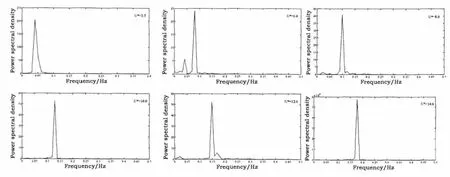
Fig.7 FFT analysis of lift coefficient at different reduced velocities for 0°flow approach angle
Fig.7 presents the fast Fourier transform(FFT)analysis of the lift coefficient at different velocities of 3.5,6.0,8.0,10.0,12.0,and 14.0 for 0°flow-approaching angle.Spectrum transform curves under different reduced velocities are relatively regular except for the reduced velocity of 6.0,which has two spectral peaks,whereas others only have one spectral peak.Thus,the energy of lift coefficient is concentrated under different reduced velocities,and vortex shedding frequency increased with the reduced velocity.Considering that the transverse natural frequency of multi-columns is 0.06 Hz,one of the spectral peaks at the reduced velocity of 6.0 corresponds to the natural frequency of multi-columns,whereas the other corresponds to actual vortex shedding frequency.When the vortex shedding frequency is equal to the natural frequency of multi-columns,the lock-in phenomenon appears.

Fig.8 Equilibrium position of stream-wise amplitude at different velocities

Fig.9 Normalized frequency at different reduced velocities for 0°
Fig.8 shows changing trend of the equilibrium position with different reduced velocities.The equilibrium position increases gradually with incoming flow velocity.However,the slope of the equilibrium position curve for different flow-approaching angles differed;a higher reduced velocity results in a greater slope.At a reduced velocity of 15.0,the equilibrium positions are 2.87,6.38,and 8.10 D,corresponding to 0°,22.5°,and 45°headings,respectively.Under the same reduced velocity,the characteristic length of multi-columns change with the flow-approaching angle.The characteristic length of 45°heading is 1.41 times larger than the size of the 0°heading.The equilibrium position from the initial position is larger than higher mesh quality requirement.
Fig.9 shows that spectral transform of the lift coefficient for 0°under different reduced velocities.The changing trends for limited and unlimited motion in stream-wise direction are identical.With an increase in reduced velocity,the frequency of the lift coefficient increases linearly.For limited motion condition, ‘lock-in’ phenomenon appears at a reduced velocity of 2.5 to 3.5.The author investigated galloping under the low-frequency phenomenon for a square column at a mass ratio of 2.6.Galloping under the low-frequency phenomenon occurred for limited motion in the stream-wise direction at a reduced velocity of 4.0 to 5.8.Notably,the step-jump phenomena appeared for normalized frequency when the reduced velocity was less than 11.0.The stream-wise motion is limited in Fig.9,and the size of vortex shedding frequency is the same as that of the adjacent reduced velocity.
4.2 Research on the influence of flow-approaching angle on VIM
The paper has researched the influence of different flow-approaching angle on the amplitude,region of lock in and equilibrium position in stream-wise direction.Time history of VIM has been given for 22.5°and 45°headings in Figs.10 and 11.The study found that synchronization phenomena evidently emerged in the time-history curve of VIM in the stream-wise and transverse directions at a reduced velocity of 3.0 for 22.5°flow-approaching angle.The peaks and valleys of the time-history curve appeared almost simultaneously.The underlying cause lies in the characteristics of the lift-and-drag coefficient.The transverse amplitude of VIM is 0.43 D,whereas the stream-wise amplitude is 0.39°.Thus,the transverse amplitude is slightly greater than the stream-wise amplitude.The equilibrium position of multi-columns is about 0.31 D.With an increase in reduced velocity,the time-history curve shows a random characteristic.When the reduced velocity further increased to 6.0,8.0 10.0,12.0,and 14.0,the space between transverse and stream-wise time history curves enlarged,multi-columns gradually vibrated farther from the initial position,and randomicity was enhanced.If the maximum statistical method is used,larger errors may occur,which may affect the judgment and understanding of the motion trend.Therefore,the nominal statistical method must be used from the randomicity angle.
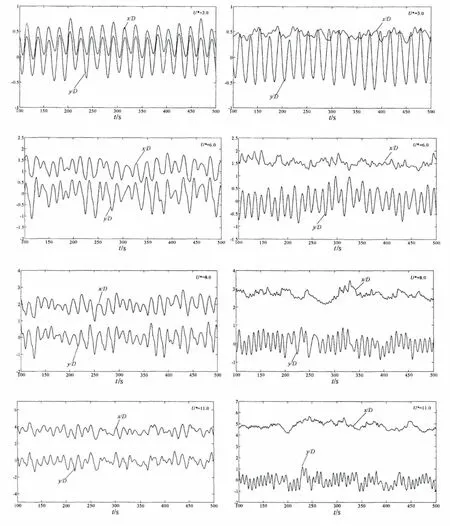

Fig.10 Time histories of stream-wise and transverse amplitudes for 22.5°(unlimited motion in the stream-wise direction)

Fig.11 Time histories of stream-wise and transverse amplitudes for 45°(unlimited motion in the stream-wise direction)

Fig.12 Stream-wise amplitude in related with the induced velocity

Fig.13 Transverse amplitude relative to induced velocity
Figs.12 and 13 show the changing trend of stream-wise and transverse amplitudes with reduced velocity using the maximum and nominal statistical methods,respectively.The variations of stream-wise amplitude along with reduced velocity are analyzed.The changing trends of the two different statistical results are coincident when comparing Figs.12(a)and(b).Flowapproaching angles significantly affect the transverse amplitude.The amplitude curve is relatively flat at a 0°approaching angle.The threshold value is approximately 4.0 for the maxi-mum statistical method,whereas the nominal statistical threshold value is 5.5.Regardless of the statistical method employed,the transverse amplitude will lock in a valve and will change in the vicinity of this value when the reduced velocity exceeds the threshold value.The value for the maximum statistical method is 0.28 D,which is larger than the nominal statistical value of 0.18 D.When the flow-approaching angle increases to 22.5°,the stream-wise amplitude increases linearly with reduced velocity ranging from 1.5 to 4.0 for both statistical methods.A buffer stage for reduced velocity exists between 4.0 and 6.0.At this stage,transverse amplitude is relatively stable.When the reduced velocity exceeds 6.0,the growth rate of streamwise amplitude significantly increases.When the flow-approaching angle is 45°,variation trend of stream-wise amplitude is similar to that of 22.5°heading but enters a sharp vibration stage faster than other cases.The present studies on the vortex-induced characteristics for the spar platform,semi-submersible platform,and TLP primarily consider the 0°flow approaching-angle condition.Given that the cross section of a spar platform is a circular cylinder,the effect of flow-approaching angle can be ignored.Semi-submersible platform and TLP are types of multi-column platforms,and regardless of whether the section of platform is a circular cylinder or a square cylinder,the flow-approaching angle significantly affects the amplitude of VIM.Researches on the VIM of a single column have shown that transverse amplitude is larger than the stream-wise amplitude.Although VIM is present in the other freedom,the motion response of heaving and other rotational freedom are one to two orders of magnitude smaller than transverse and stream-wise motion,which is also the reason why VIM research considers the two main freedoms.Using the limited computing resources and computing time for these two leading freedoms can also further explain the VIM mechanisms of emergence,evolution,and development.
At the steady stage for 0°heading,the transverse amplitude is 0.45 D,and stream-wise amplitude is 0.28 D for the maximum statistical method.For the nominal statistical method,the transverse amplitude is 0.32 D,and the stream-wise amplitude is 0.18 D.Regardless of the statistical method employed,the transverse amplitude is 1.7 times larger than the streamwise amplitude,which similar to the conclusion of on the VIM of a single column for 0°heading.
5 Conclusions
The VIM of multi-columns has been numerically simulated based on computational fluid dynamics combined with the self-development program of fluid-structure interaction.The effect of limited or unlimited motion in stream-wise direction on VIM has been studied.GAMBIT software was utilized to mesh the model,and a movement zone is set up near the multicolumns,where structured grids near the wall are used.A program in C language was manually written into the user-defined functions and embedded into the solver.Dynamic mesh tech-nology was adopted to update the flow field.Simulations were conducted for flow-approaching angles of 0°,22.5°and 45°.The conclusions are as follows:
(1)This paper has taken multi-columns with low mass ratio as the research object.The cross sections of the columns are square cylinders.Given the difference of the vortex-induced characteristics between circular cylinder and square cylinder as well as the interaction among the columns,the maximum and the nominal statistical methods were adopted to analyze the data.Regardless of whether stream-wise motion is limited,the “leap” phenomenon of transverse amplitudes appeared at 0°heading at a reduced velocity of 2.5 to 3.5.When the stream-wise motion was limited,the maximum transverse amplitude was 0.57 D.For the unlimited streamwise motion condition,the maximum transverse amplitude was 0.53 D.The statistical results of VIM for the two different conditions are very close.When the reduced velocity exceeded 5.0,the magnitude of transverse amplitude for unlimited condition became larger than that of the limited condition.A “lock-in” phenomenon occurred under both conditions,but the magnitude of“lock-in” amplitude and “lock-in” region differed.
(2)Under the unlimited motion condition,the variation trend of the equilibrium position with reduced velocity was more regular,and the distance between the stream-wise equilibrium position and the initial position for 45°was larger than that of the 22.5°heading and 0°heading at the same reduced velocity.The distance of the 0°flow-approaching angle was the least.When the reduced velocity was lower than 11.0°for 0°,a multiple-frequency “lock-in”phenomenon appeared under the unlimited motion condition.At a reduced velocity of 2.5 to 3.0,the phenomenon of galloping at low frequency occurred.
(3)In terms of low reduced velocity of the three typical flow-approaching angles,the timehistory curve of VIM became more regular,and the phase synchronization phenomenon between lift coefficient curve and drag coefficient curve appeared.As the reduced velocity increased,the randomness of hydrodynamic coefficient curve evidently increased.For 0°flowapproaching angle,the variation trend of transverse and stream-wise amplitudes with reduced velocity changed more gently.For a 22.5°heading,the variation trend of stream-wise amplitude can be divided into three stages:linear increasing stage,buffer stage,and sharp linearly increasing stage.The variation trend of 45°is similar to that of 22.5°but increased more rapidly.Using the nominal statistical method at low reduced velocity,the transverse and streamwise amplitudes of 22.5°heading and 45°heading are very close to each other,with both being larger than the amplitude of 0°heading.
(4)The vortex shedding pattern of multi-columns with low mass ratio showed the 2P mode.Flow-approaching angle,time and reduced velocity significantly affected the vortex shedding position and vortex shedding pattern.
[1]Govardban R,Williamson C H K.Modes of vortex formation and frequency response of a freely vibrating cylinder[J].Journal of Fluid Mechanics,2000,420:85-130.
[2]Jauvtis N,Williamson C H K.Vortex-induced vibration of a cylinder with two degrees of freedom[J].Journal of Fluids and Structures,2003,l7:l035-l042.
[3]Jauvtis N,Williamson C H K.The effect of two degrees of freedom on vortex-induced vibration at low mass and damping[J].Journal of Fluids Mechanics,2004,509:23-62.
[4]Govardhan R,Williamson C H K.Defining the modified Griffin plot in vortex-induced vibration revealing the effect of Reynolds number using controlled damping[J].Journal of Fluid Mechanics,2006,561:147-180.
[5]Sumner D.Closely spaced circular cylinders in cross-flow and a universal wake number[J].ASME,Journal of Fluids Engineering,2004,126:245-249.
[6]Sumner D,Richards M D,Akosile O O.Two staggered circular cylinders of equal diameter in cross-flow[J].Journal of Fluids and Structures,2005,20:55-276.
[7]Yalpaniyan A,Goodarzi M.The free surface flow around a TLP[C].Proceedings of the ASME 2010 29th International Conference on Ocean,Offshore and Arctic Engineering,2010,OMAE,20021.
[8]Allan Magee,Rizwan Sheikh,Kenneth Yeoh Hock Guan.Medel tests for VIM of multi-column floating platform[C].Proceedings of the ASME 2011 30th International Conference on Ocean,Offshore and Arctic Engineering,OMAE,2011-49151.
[9]Jang-Whan Kim,Allan Magee,Kenneth Yeoh Hock Guan.CFD simulation of flow-induced motions of a multi-column floating platform[C].Proceedings of the 30th International Conference on Ocean,Offshore and Arctic Engineering,OMAE,2011,49437.
[10]Waals O J,Bultema S.Flow induced motions of multi column floaters[C].Proceedings of the 26th International Conference on Offshore Mechanics and Arctic Engineering,OMAE,2007:669-678.
[11]Huang Zhiyong.Pan Zhiyuan,Cui Weicheng.Numerical simulation of VIV of a circular cylinder with two degrees of freedom and low mass-ratio[J].Journal of Ship Mechanics,2007,11(1):1-9.
[12]Zhao Ming,Cheng Liang.Numerical simulation of vortex-induced vibration of four circular cylinders in a square configuration[J].Journal of Fluids and Structures,2012,31:125-140.
[13]Xu Feng,Ou Jinping,Xiao Yiqing.Numerical study on vortex induced vibrations of four cylinders in an in-Line square configuration[J].Computational Structural Engineering,2009:553-567.
[14]Rijken O,Leverette S.Experimental study into vortex induced motion response of semi submersibles with square columns[C].Proceedings of the ASME 27th International Conference on Offshore Mechanics and Arctic Engineering,2008,OMAE,57396.
[15]Jimmy Ng K T,Halkyard J E,Soon C Eng.Statistical characteristics of flow in the wake region of a vertical bluff cylinder in waves,currents and combined wave-current flows[C].OMAE,2010-21181.
[16]Hong Yongpyo,Choi Yongho,Lee Junyoung,Kim Youngbok.Vortex-induced motion of a deep-draft semi-submersible in current and waves[C].Proceedings of the 18th International Society Offshore and Polar Engineering,ISOPE,2008:453-459.
低质量比多立柱涡激特性研究
谷家扬1,杨建民2,肖龙飞2
(1.江苏科技大学 船舶与海洋工程学院,江苏镇江 212003;
2.上海交通大学 海洋工程国家重点实验室,上海200240)
多立柱海洋平台的涡激运动是非常复杂的流固耦合问题也是近年来海洋工程领域的研究热点。文章引入雷诺平均法求解NS方程、结合SST k-ω湍流模型采用耦合算法对低质量比多立柱在不同流向及流速下的涡激运动进行了数值研究,立柱运动固有周期及无因次阻尼系数取自上海交通大学海洋工程国家重点实验室的相关实验数据。采用分区法建立了计算网格,多立柱和流场的流固耦合通过计算外部流场作用于柱体的瞬时升力和拖曳力,将求解运动微分方程的四阶Runge-Kutta代码嵌入UDF求解器中,运用动网格技术实现流场更新并采用最大值统计法和标称统计法对涡激运动振幅幅值进行统计,研究发现:0°流向较小约化速度时,无论限制流向是否,振幅都存在跳跃现象,不限制流向下横向最大振幅为0.50 D,略小于限制流向的0.57 D,较大约化速度时,横向振幅出现了锁定现象,但是否限制流向和统计方法的选取对锁定区间长短有所影响,0°及45°流向时候观测到了低频驰振及多频短暂锁定现象,三个典型流向下流向平衡位置随流速的变化趋势基本相近。不限制流向下约化速度大于6.0时,采用标称统计法得到的22.5°流向横向振幅最大,0°流向最小,多立柱尾涡结构形式表现为2P模式。
多立柱;涡激运动;动网格;频率锁定;低质量比
P751
A
谷家扬(1979-),男,博士,江苏科技大学船舶与海洋工程学院副教授;
肖龙飞(1973-),男,博士,上海交通大学研究员。
1007-7294(2014)09-1055-17
date:2014-04-01
Supported by National Natural Science Foundation of China(51309123,51279104);Jiangsu Province Natural Science Research projects in Colleges and Universities(13KJB570002);Jiangsu Province Key Laboratory of Advanced Design and Manufacturing Technology of Ship Open Research Fund Project(CJ1203);Academic Program Development of Jiangsu Higher Education Institutions(PAPD).
Biography:GU Jia-yang(1979-),male,Ph.D.,associate professor of Jiangsu University of Science and Technology,E-mail:gujiayang@126.com;Yang Jian-min(1958-),male,professor/tutor of Shanghai Jiaotong University;Xiao Long-fei(1973-),male Ph.D.,researcher.
book=1056,ebook=475
P751
A
10.3969/j.issn.1007-7294.2014.09.005
book=1070,ebook=489
book=9,ebook=490
杨建民(1958-),男,上海交通大学教授,博士生导师;
猜你喜欢
杂志排行
船舶力学的其它文章
- Research on Multidisciplinary Design Optimization Methods for Cylindrical Underwater Vehicle
- An Analysis of Mean Wave Drift Forces of FPSO Systems by Higher-order Boundary Element Method
- Thrust Allocation with Dynamic Forbidden Sectors in Dynamic Positioning System
- Research of Vertical Bending Moment in Amidships Calculation Method Caused by the Crash-breaking Way
